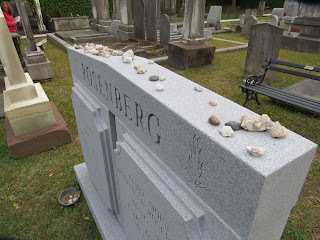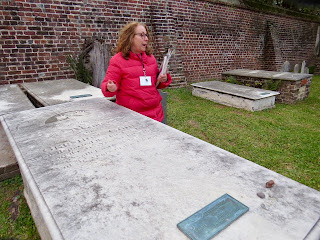I have driven on Coming Street for years and never really noticed this spot as I head to I-26 to go home.
Only fairly recently did I know that behind this high, foreboding and gloomy looking wall is one of the oldest and most historic cemeteries in Charleston.
It is, in fact, the oldest Jewish cemetery in the South and one of the oldest in America.
This is the Coming Street Cemetery. On April 1, with my College of Charleston “Beyond the Grave” students, I was for the first time within the dark walls.
We were met by two guides, Randi Serrins (left in this photo holding a picture) and Anita Moise Rosenberg. They spent about an hour with us and were excellent historians about this special place.
If you are interested in setting up a tour, call 843.723.1090, contact Rosenberg at anitamrose@comcast.net or Serrins at randiserrins@gmail.com
With our large class, they wisely split us into two groups, making it easier to move around the one acre site that is filled with stones and statuary, not to mention 800 people in 500 gravesites (some family members were buried side by side).
The cemetery is kept locked so if you want to do more than look in through the gate, see again the contact information given above.
Coming Street Cemetery is the eternal home for hundreds of members of Kahal Kadosh Beth Elohim (Holy Congregation House of God) synagogue. KKBE, as it is called for short, is very historic. Founded in 1749, it is one of the oldest Jewish congregations in America. It is also the "cradle" of Reform Judaism, a move away from Sephardic Orthodox traditions.
In the above photo, Serrins holds a drawing of the first building, which was wooden and had a steeple, she said, that resembled Charleston's St. Michael's Episcopal Church. It was built in 1794 then burned to the ground in the Great Charleston Fire of 1838. It would be replaced in 1840 by the beautiful Greek temple-like synagogue pictured above (photo courtesy of the Jewish Historical Society of South Carolina). Located at 90 Hasell St. it has the distinction of being the U.S.'s oldest synagogue in continuous use.
Before my students and I walked to the Jewish cemetery, I went over this article which looked at how different religions in America bury their dead. We had visited several Christian church graveyards so I wanted to bring out some of the Jewish distinctions in this area.
It was not mentioned in the article we reviewed, but I asked our guides something I had read somewhere else that Jewish cemeteries are not located by the church as is common at Catholic and Protestant churches (ie churchyards). Our guides explained that in Judaism the "priestly class cannot deal with dead bodies" and cannot go into cemeteries.
Another Jewish burial tradition is that markers and monuments are generally not erected until 11 or 12 months after the person is buried when an unveiling occurs to dedicate the gravestone.
Different too than Christian burial customs, is how Jews are buried only in wooden boxes so that they (the box and the body within) will deteriorate into the ground, a more natural end to life.
Also, traditionally, Jews do not believe in embalming or cremation.
Another custom, that I have noticed having visited two Jewish cemeteries near Magnolia Cemetery in Charleston, is small rocks or pebbles placed on grave markers. The guides said that Jews do this because stones last longer than flowers as a way to honor and remember the deceased. "Flowers are impermanent and die," Serrins said.
Hebrew writing is on many markers. Some have inscriptions and epitaphs all in the ancient language, others a mix of Hebrew and English, and many others are entirely in English.
Engravings of hands like the above are on many Jewish gravestones. Some call these "Spock" hands after the Vulcan "Star Trek" character who would create a V shape by spreading his fingers to symbolize "live long and prosper." The actor Leonard Nimoy, himself Jewish, brought that personal touch to the show. It actually represents a "priestly blessing or benediction."
The types of grave markers at Coming Street Cemetery are the same as seen at Charleston's church graveyards from the 18th and 19th century. Coming Street has, in a compact area, a rich array of box tombs, pedestals, obelisks, die on socket and base, and regular one piece headstones.
This is one of my favorites for its beauty and grave iconography or symbolism. Leidloff is the name on this marker.
Serrins told us how Jews were allowed to assemble and thrive in early Charleston. "For the most part, Jews here never experienced anti-Semitism," she said. "Charleston society accepted Jews." The one religion that had difficulties with prejudice was Catholicism. In a later email about this, Serrins and Rosenberg explained: "Catholics were discriminated against because England and Spain were constantly at war and Spain held St. Augustine, Florida. The Spanish were Catholic. The British in Charles Towne we’re afraid that they would be attacked by the Spanish living in St. Augustine. The first Catholics came here in 1788."
The otherwise religious tolerance in Charleston was due, in part, to the policies of Lord Ashley Cooper, who was appointed by England's King Charles II in the late 1600s to be Lord Proprietor of the Province of the Carolinas. A marketing tactic to motivate Europeans to move to the Carolina colony, more than an act of benevolence, Cooper allowed, even encouraged, groups of just seven believers to form their own religions. This would give Charleston an unequaled religious diversity.
This is a topic we've explored in my class "Beyond the Grave: What Old Cemeteries Tell and Teach the Living." Read more in my previous blog post. Charleston historian, author and tour guide Ruth Miller is an excellent source on the how the "Holy City" became so holy and so religiously diverse.
KKBE's first spiritual leader, Moses Cohen, would be the first person buried here on Coming Street in 1762. The slate top to his box tomb has writing on it from top to bottom, including a poem in Hebrew.
This is an aside, but another thing I learned on this tour is the meaning of the words "relict" and "consort"- words I have seen on several 19th-century grave markers in Charleston and other places. A wife may be identified as a "consort" if she died before her husband. "Relict" is a widow, her husband having died before she did.
Charleston Jews would be well represented in the Confederate Army during the Civil War from 1861-1865. Twenty-one soldiers are buried or memorialized here including several who were killed in action. One was Marx E. Cohen Jr. who would die in one of the last major battles, Bentonville, in early 1865. Serrins explained (above) that his richly engraved obelisk is a cenotaph, meaning that Cohen is not buried here. His body was never recovered from the battlefield. This marker is in his honor.
The images include a plugged cannon, symbolizing that he was killed in battle. This is a first for me, having never seen this icon before.
Serrins (above holding a photo of another Confederate soldier buried here who was killed in battle- there's a ghost story with this one!) said there was little if any hesitation from Jewish men as far as joining the Southern fight against the North. "Some were recent immigrants," she said, "and they were so grateful for what the country had to offer that they were willing to fight for it." Other Jewish soldiers came from established Charleston families and that's just what Southern men did- fight for the Confederacy.
Coming Street Cemetery also has the graves of nine Revolutionary War soldiers and six from the War of 1812.
We learned the sad story of two boys, each 7 years old, who died from a yellow fever epidemic that swept through Charleston in 1854.
Serrins held up a picture of one of the young victims.
The boys, Israel and Robert, were buried together in this lovely fenced plot.
The stories abound and Randi Serrins and Anita Moise Rosenberg expertly tell them and have visuals to show with many. David Lopez owned a construction business that would erect the KKBE synagogue in the mid-1800s. And Penina Moise was a prominent poet in her time.
I enjoyed seeing another zinc metal marker that was made by the Monumental Bronze Co. out of Bridgeport, Conn. Magnolia Cemetery has one too.
Thank you to Randi Serrins and Anita Moise Rosenberg for this memorable visit. I look forward to coming back to the Coming Street Cemetery with future classes! So much history and other interesting things to learn about in a compact space, indeed.


























1 comment:
Great article. I am a city guide and I also do tours of the Coming Street Cemetery. Randi and Anita are excellent teachers and all of Charleston should be grateful to them for bringing this fascinating place to the attention of so many visitors and locals alike. I learned about the cemetery from the late historian Sol Briebart, who is buried there now beside his wife Sara. Randi and Anita have added so much to the research material that he left us. Thanks also for giving credit to my friend and colleague Ruth Miller, an expert on Charleston's historic graveyards. Rhetta Mendelsohn
Post a Comment